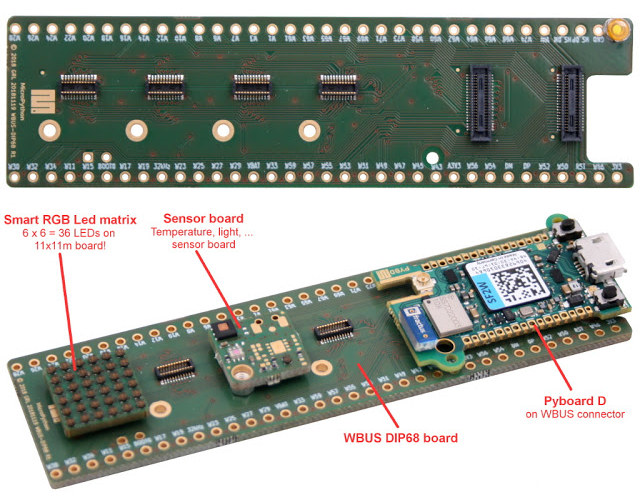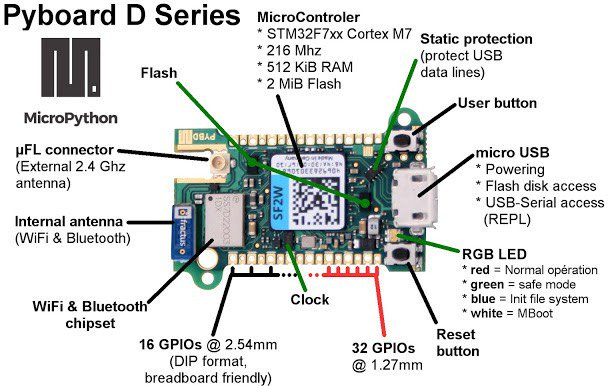Micropython is a lightweight implementation of Python for microcontroller which we covered first in 2013. The port is supported by various hardware platforms, and I even tested Micropython on ESP32 a little while ago, but the developer – Damien George – also launched officially supported boards starting with Pyboard in 2014 with an STM32F4 microcontroller.
At FOSDEM 2019, the upcoming Pyboard D-series (aka Pyboard D, or just PyBD) board was introduced during the Micropython presentation with a faster STM32F7 Cortex-M7 MCU, as well as built-in WiFi and Bluetooth connectivity.
Pyboard D preliminary specifications:
- MCU – STMicro STM32F7xx Arm Cortex M7 microcontroller at 216 MHz with 512KB RAM, 2MB flash
- Storage – micro SD card slot, and 2x external flash chips
- Connectivity – WiFi & Bluetooth with on-board antenna and u.FL antenna connector
- USB – 1x micro USB port for power, flash disk access, and USB to serial debugging/programming
- Expansion
- 2.54mm pitch through holes for 16x GPIOs
- 1.27mm pitch castellated and through holes for 32x GPIOs
- 2x 40-pin WBUS connectors for a total of 59 GPIOs
- Misc – User and reset buttons, RGB LED, clock
- Dimensions – TBD
 The board can be programmed with MicroPython either from the command line, copying the Python file to the board (seen as a USB flash drive from your computer), or via WiFi using WebREPL terminal client.
The board can be programmed with MicroPython either from the command line, copying the Python file to the board (seen as a USB flash drive from your computer), or via WiFi using WebREPL terminal client.
The WBUS connectors are also new and will allow you to stack add-ons boards, for example the WBUS DIP28 or DIP68 boards exposing respectively 28 and 68 I/O pins, and which themselves can takes one or more sensor board(s) via other smaller 2x 10-pin sensor board connectors.

There’s also an eMMC WBUS board for extra storage, and I’m sure more WBUS boards may be planned. You’ll find more details on MCHobby’s blog post (in French).
There were a few samples on offer at FOSDEM 2019, but the only pricing and availability information I know of is that the board will be available in a few days or weeks.
Via Adafruit Blog

Jean-Luc started CNX Software in 2010 as a part-time endeavor, before quitting his job as a software engineering manager, and starting to write daily news, and reviews full time later in 2011.
Support CNX Software! Donate via cryptocurrencies, become a Patron on Patreon, or purchase goods on Amazon or Aliexpress





